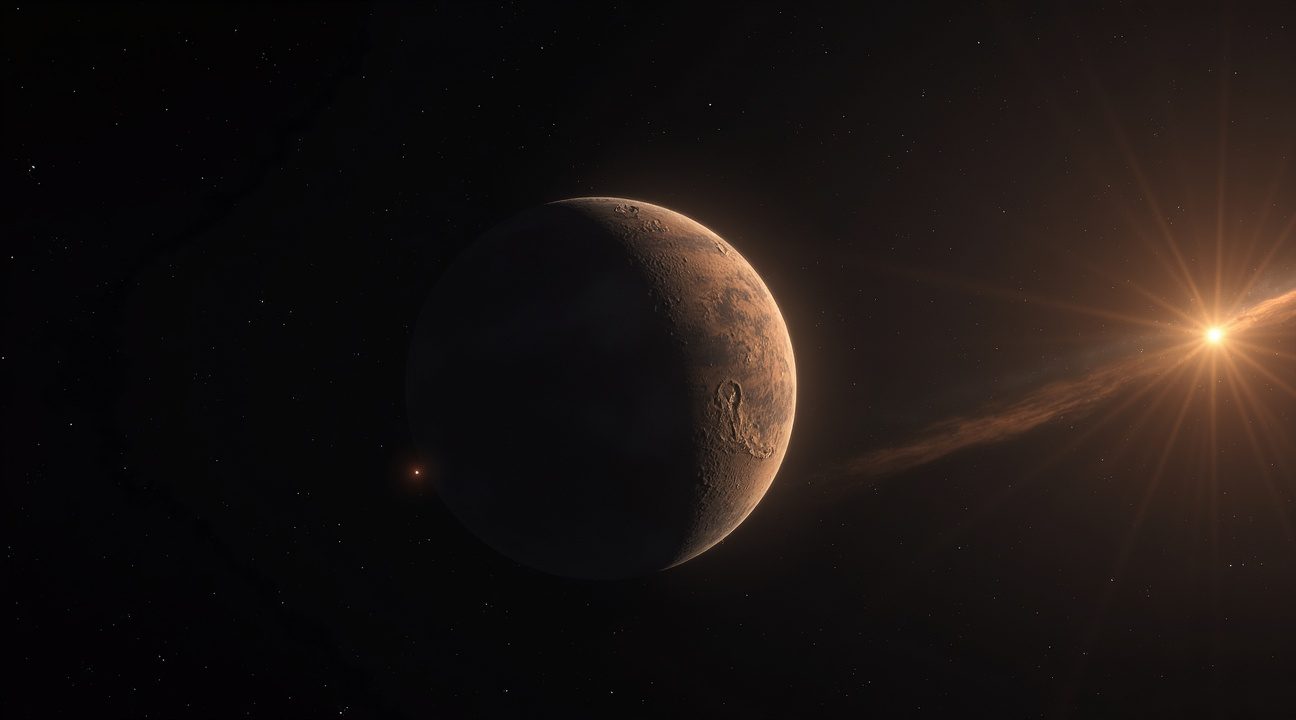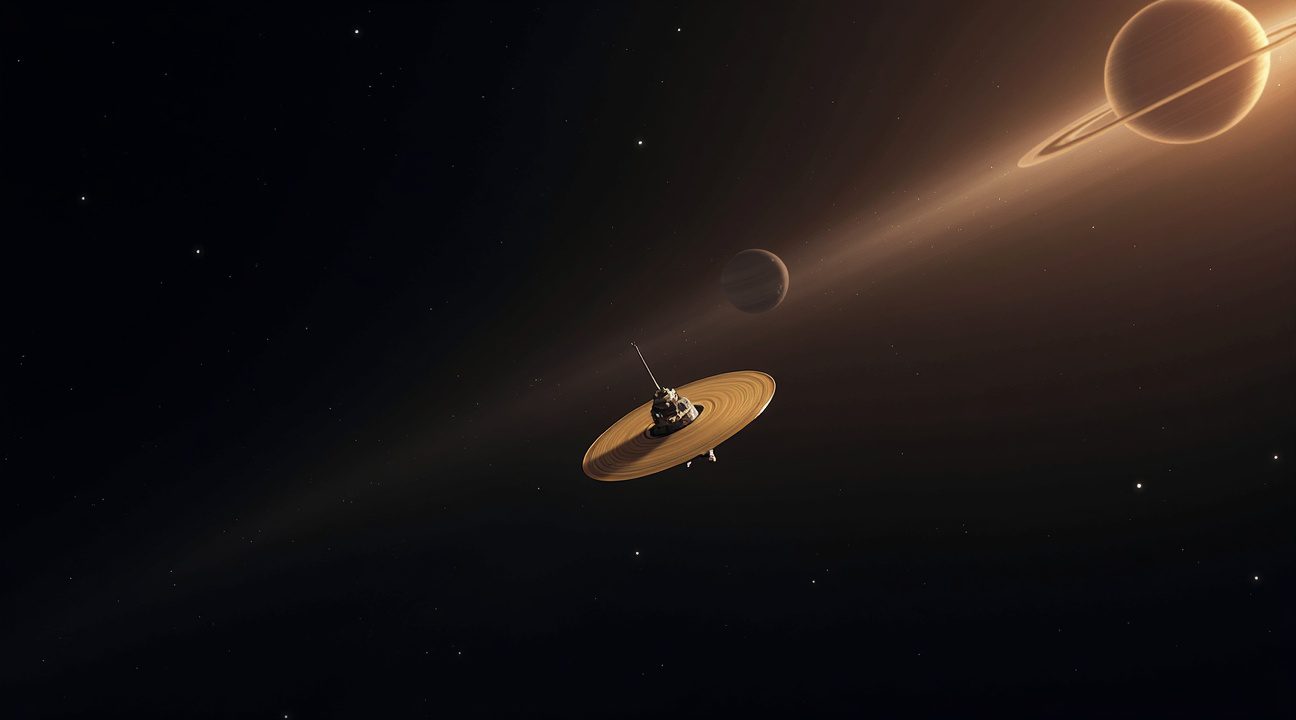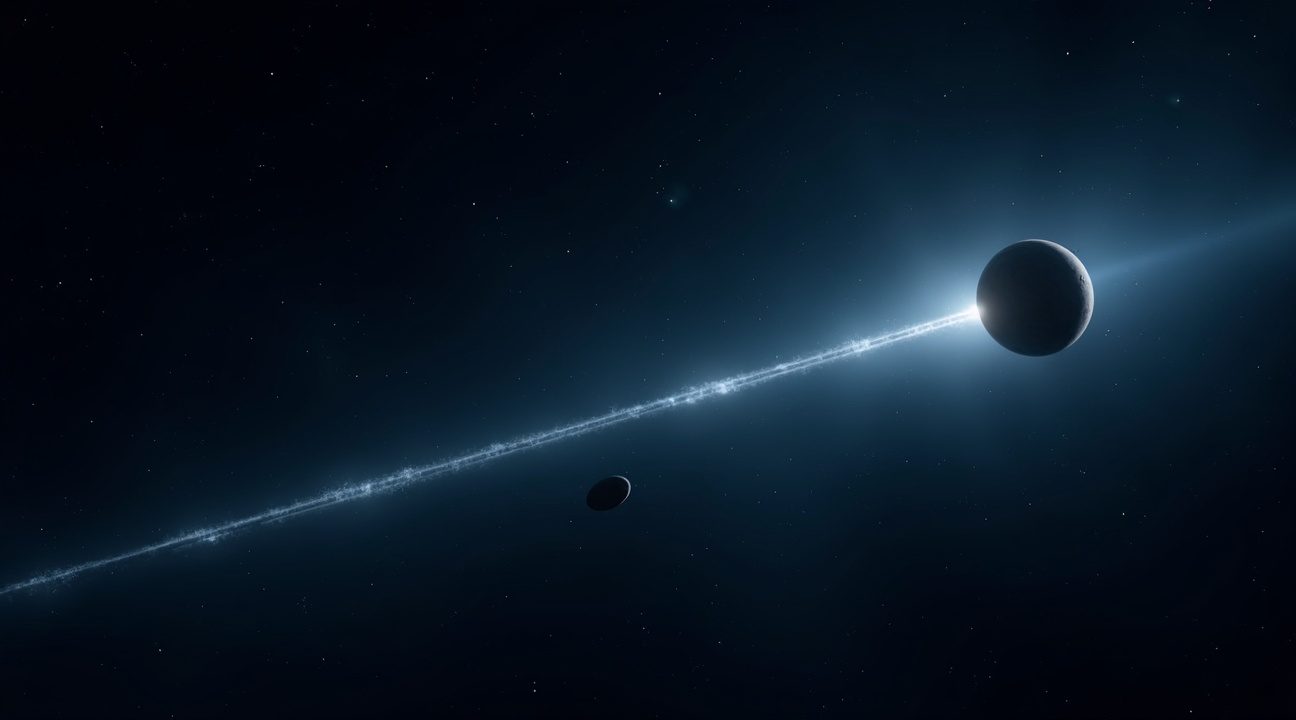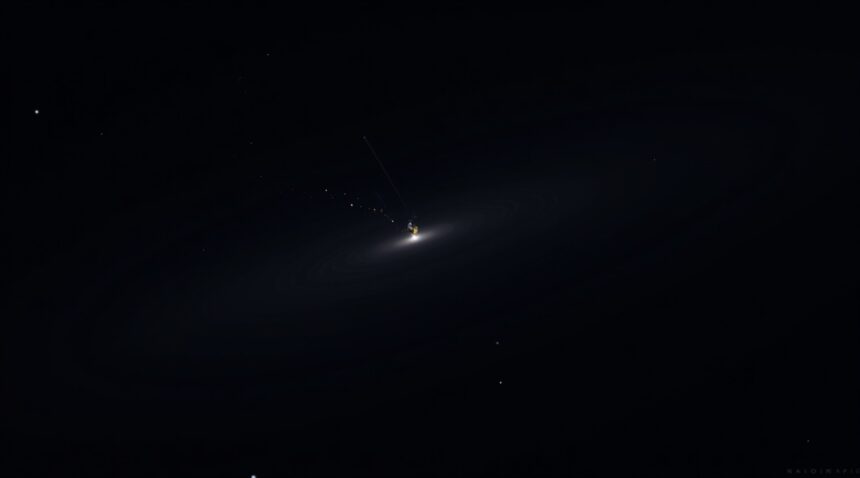NASA’s Voyager 1 spacecraft is set to make history on November 15, 2026, when it becomes the first human-made object to reach one light-day away from Earth, demonstrating a monumental achievement in space exploration.
Key Takeaways
- Voyager 1 will reach one light-day from Earth on November 15, 2026, having traveled a staggering 25.9 billion kilometers since its launch in 1977.
- Communication delays will increase to a 48-hour round-trip, with radio signals taking 24 hours to reach the spacecraft and another 24 hours to return to Earth.
- The spacecraft continues to transmit important scientific data about interstellar space, even as its nuclear power source gradually declines.
- Voyager 1 entered interstellar space in 2012 and is currently moving away from Earth at an impressive speed of 17 kilometers per second.
- Contact with Voyager 1 is expected to continue until sometime between 2025 and 2030, when power constraints will likely end data transmissions permanently.
Voyager 1’s Legacy and Scientific Contributions
Pushing the Boundaries of Exploration
Since its launch, Voyager 1 has continually surpassed expectations, not only visiting Jupiter and Saturn but also delivering lasting insights into the outer regions of our solar system. Upon crossing into interstellar space in 2012, it began providing unprecedented data about the environment beyond our Sun’s influence.
Challenges of Long-Distance Communication
The new milestone introduces a significant challenge: with a 48-hour communication loop, NASA’s Deep Space Network will have to make careful decisions when transmitting commands. The increased delay forces mission control to operate in a more autonomous and predictive manner to minimize risks and delays in spacecraft response.
Future of the Mission
Though the spacecraft is nearly half a century old, Voyager 1 remains operational. However, dwindling power supplies mean that by around 2025 to 2030, its instruments will gradually be deactivated. Despite that, the legacy of Voyager 1 will live on in the data it has returned and the boundaries it has helped humanity push.
Voyager 1 Makes Historic First: Reaching One Light-Day from Earth This November
NASA’s Voyager 1 spacecraft stands on the brink of a historic achievement. On November 15, 2026, this remarkable probe will become the first human-made object to travel one light-day from Earth. The spacecraft will reach a distance of 25.9 billion kilometers (16 billion miles), marking an unprecedented milestone in space exploration history.
Understanding the significance of this achievement requires grasping what a light-day actually represents. A light-day measures the distance light travels in 24 hours, covering exactly 25.9 billion kilometers or 16 billion miles. Light moves at approximately 299,792,458 meters per second in a vacuum, making this distance calculation both precise and meaningful for space navigation.
Communication Challenges at Unprecedented Distances
The practical implications of reaching one light-day become clear when considering communication protocols. Radio signals from Earth will require 24 hours to reach Voyager 1 at this distance. Any response from the spacecraft will take another 24 hours to return to Earth, creating a 48-hour round-trip communication delay. This extended delay fundamentally changes how mission controllers interact with the spacecraft, requiring careful planning for every command sequence.
NASA engineers have already adapted their operational procedures to accommodate these growing delays. Commands must be precisely calculated and thoroughly tested before transmission, as real-time corrections become impossible. The communication process resembles sending letters rather than having conversations, demanding exceptional foresight from mission planners.
At this historic distance, Voyager 1 will be approximately 166 astronomical units (AU) from Earth. One AU represents the distance between Earth and the Sun, roughly 150 million kilometers or 93 million miles. This perspective helps visualize just how far Voyager 1 has traveled since its launch in 1977.
The spacecraft continues transmitting valuable scientific data despite its incredible distance from home. Its instruments monitor the interstellar medium, providing insights into the space between stars that no other human-made object has directly studied. These measurements contribute to our understanding of cosmic phenomena and the structure of our local galactic neighborhood.
Voyager 1’s journey represents more than just distance records. The mission demonstrates humanity’s capability to design and operate technology across decades of space travel. The spacecraft’s longevity exceeds all original expectations, continuing to function nearly 50 years after launch. Modern space missions, including those by SpaceX, continue building on the foundation established by pioneering missions like Voyager.
Current estimates suggest Voyager 1 moves away from Earth at approximately 17 kilometers per second relative to the Sun. This velocity ensures the spacecraft will continue setting distance records for years to come. The probe’s trajectory carries it through the heliopause, the boundary where solar wind gives way to interstellar space.
Scientists expect Voyager 1 to maintain contact with Earth until approximately 2025–2030, depending on power levels and system functionality. The spacecraft’s radioisotope thermoelectric generators provide decreasing power output each year, gradually limiting which instruments can remain operational. Mission controllers regularly shut down non-essential systems to conserve energy for the most critical scientific instruments and communication equipment.
The November 2026 milestone connects to broader space exploration achievements. Recent missions have discovered essential building blocks for life on Saturn’s moons, while India’s Chandrayaan-3 successfully explored the lunar surface. These missions, along with innovative propulsion concepts, continue expanding humanity’s reach into space.
Voyager 1’s achievement will stand as a testament to human engineering and scientific curiosity. The spacecraft carries the famous Golden Record, containing sounds and images from Earth, making it humanity’s most distant ambassador. This historic milestone represents not just distance traveled, but the enduring spirit of exploration that drives us to reach beyond our planetary boundaries.

The Extraordinary Journey: From Jupiter Mission to Interstellar Pioneer
Voyager 1 began its incredible voyage in 1977 with a straightforward mission: study Jupiter and Saturn during their favorable planetary alignment. I find it remarkable that what started as a four-year mission to explore these gas giants has evolved into humanity’s longest-running space mission, spanning nearly five decades.
The spacecraft’s transformation from planetary explorer to interstellar pioneer represents one of NASA’s greatest successes. After completing its primary objectives at Jupiter and Saturn, Voyager 1 continued its outward journey, propelled by the gravitational assists it received during those planetary encounters. This extended mission has allowed scientists to gather unprecedented data about the outer reaches of our solar system.
Breaking Barriers in Deep Space
The most significant milestone in Voyager 1’s journey occurred in 2012 when it became the first human-made object to cross the heliopause. This boundary marks where the solar wind from the Sun ceases to dominate space, effectively separating our solar system from interstellar space. I consider this achievement particularly impressive because scientists had only theoretical models of this region before Voyager 1’s historic crossing.
Currently traveling at approximately 61,000 kilometers per hour (38,000 miles per hour), Voyager 1 maintains an impressive speed that would allow it to circle Earth in just over 40 minutes. However, the vast scale of space puts this velocity into perspective—despite this remarkable speed, it has taken nearly five decades for the spacecraft to travel just one light-day from Earth. This distance milestone, expected in November 2026, demonstrates the enormous scales involved in space exploration.
The scientific return from this extended mission has been extraordinary. Voyager 1 has already transmitted over five trillion bits of scientific information back to Earth, equivalent to more than 7,000 music CDs worth of data. This wealth of information continues to reshape our understanding of the solar system’s boundaries and the nature of interstellar space.
Modern space missions like those conducted by SpaceX and other space agencies build upon the foundational knowledge gathered by Voyager 1. The spacecraft’s longevity has also inspired ambitious projects, including NASA’s innovative propulsion concepts that could potentially send future missions even farther into deep space.
The engineering behind Voyager 1’s continued operation astounds me. Its nuclear power source, a radioisotope thermoelectric generator, still provides enough electricity to power essential instruments and maintain communication with Earth. Mission controllers carefully manage the spacecraft’s declining power budget, shutting down non-essential systems to extend its operational life as long as possible.
Discoveries from Saturn’s moons during Voyager 1’s initial mission continue to influence current exploration strategies. The spacecraft’s observations helped identify potential targets for future missions, including those that might search for signs of life beyond Earth.
As Voyager 1 approaches its light-day milestone, it serves as a testament to human ingenuity and our desire to explore the unknown. The spacecraft carries the famous Golden Record, containing sounds and images representing Earth’s diversity, making it not just a scientific instrument but also humanity’s first interstellar ambassador. Its journey reminds us that exploration requires patience, perseverance, and the vision to see beyond immediate objectives.
The data Voyager 1 continues to transmit helps scientists understand the local interstellar medium and magnetic field structures beyond our solar system. Each transmission provides insights that will inform the design of future interstellar missions, potentially including commercial space ventures that might one day follow in Voyager’s path.

Deep Space Communication: The Challenge of Cosmic Distances
When Voyager 1 reaches its historic light-day milestone in November 2026, I can only marvel at the extraordinary engineering that makes communication possible across such vast distances. The spacecraft will transmit signals at an incredibly faint 10-16 watts—power levels so minuscule they’re virtually undetectable by any standard measure. To put this in perspective, this represents less energy than what a single pixel on a smartphone screen consumes, yet NASA’s Deep Space Network manages to capture and decode these whispers from the edge of our solar system.
The Deep Space Network’s highly sensitive antennas serve as humanity’s lifeline to our most distant explorer. These massive dishes, stationed strategically around the globe, can detect signals thousands of times weaker than what consumer electronics typically handle. Each transmission from Voyager 1 carries precious scientific data across a distance that light itself takes 24 hours to traverse. This means every command sent to the spacecraft requires a full day to arrive, and any response takes another day to return—creating a minimum 48-hour conversation cycle that fundamentally changes how mission controllers operate.
The Reality of Interstellar Communication Delays
This communication delay represents more than just a technical challenge; it demonstrates the sheer scale of interstellar space exploration. Mission planners must anticipate problems and program solutions days in advance, knowing that real-time intervention becomes impossible at such distances. The spacecraft operates with remarkable autonomy, making critical decisions without Earth’s guidance while continuing its scientific observations.
Human Spaceflight Limitations in Deep Space
Comparing Voyager’s journey to human spaceflight missions reveals why robotic exploration dominates deep space operations. Apollo 10 achieved maximum speeds around 39,938 kilometers per hour during its lunar mission—speeds remarkably similar to Voyager’s velocity. However, the fundamental difference lies in mission duration and distance. While human crews can sustain themselves for weeks or months in space, the decades-long journey to reach a light-day from Earth makes human missions to such distances currently impossible with existing technology.
The power requirements alone illustrate this challenge. Voyager’s radioisotope thermoelectric generators have been gradually declining for nearly five decades, yet they still provide enough energy for basic operations. Human missions would require vastly more power for life support, heating, and communication systems over such extended periods. Current commercial space ventures focus on orbital and lunar destinations precisely because the technological and logistical challenges multiply exponentially with distance.
NASA continues pushing the boundaries of what’s possible in deep space exploration. Recent gravitational assist projects demonstrate ongoing efforts to develop more efficient methods for reaching extreme distances. Meanwhile, discoveries like essential building blocks found on Saturn’s moons prove that robotic missions continue delivering groundbreaking science from across the solar system.
The Voyager program’s success at the light-day milestone will establish new benchmarks for interstellar communication and demonstrate humanity’s ability to maintain contact with our creations across truly cosmic distances. This achievement builds upon decades of international space exploration, including missions like India’s lunar exploration program, showing how space agencies worldwide contribute to our understanding of deep space operations.
Even ambitious projects like Dubai’s space infrastructure initiatives pale in comparison to the distances Voyager traverses. The spacecraft’s signal strength at one light-day demonstrates both the limits of current technology and the remarkable achievement of maintaining any communication across such vast emptiness. Each successful data transmission proves that human ingenuity can bridge the seemingly impossible gaps between worlds, one faint signal at a time.

What Lies Ahead: Voyager’s Continuing Mission into the Cosmic Void
Voyager 1 stands alone in the vast expanse of space as the most distant spacecraft actively transmitting data back to Earth. No other mission currently approaches its remarkable distance, cementing its position as humanity’s farthest-reaching ambassador. New Horizons, despite being the second most distant spacecraft, trails significantly behind and shows no realistic prospect of overtaking Voyager 1’s pioneering journey into interstellar space.
The Golden Record’s Journey Through Infinity
Beyond its scientific instruments, Voyager 1 carries humanity’s most ambitious message to the cosmos—the golden record. This extraordinary time capsule contains a carefully curated collection of sounds, music, images, and greetings from Earth, designed to communicate the essence of human civilization to any extraterrestrial intelligence that might one day encounter it. Carl Sagan and his team crafted this cultural anthology to represent the diversity and complexity of life on our planet, from Bach’s compositions to whale songs, from greetings in dozens of languages to images of human anatomy and mathematical concepts.
The spacecraft continues its relentless push through the interstellar medium, that sparse collection of gas and dust that fills the space between stars. Each passing day takes Voyager 1 approximately 14.3 million miles farther from home, carrying its precious cargo deeper into uncharted territory. NASA scientists find themselves studying data from an environment no human-made object has ever experienced before, as the spacecraft encounters cosmic phenomena that exist only in the vacuum between stellar systems.
Looking ahead, another historic milestone awaits just months after the November 2026 light-day achievement. On January 28, 2027, Voyager 1 will reach the unprecedented distance of one light-day from the Sun itself, marking yet another first in space exploration history. This achievement will place the spacecraft in a position where sunlight takes an entire day to reach it—a mind-bending perspective on the scale of our solar system.
NASA’s innovative propulsion projects continue advancing space exploration capabilities, though none will match Voyager’s singular journey for decades to come. The spacecraft’s mission exemplifies how space exploration initiatives can transcend their original parameters, becoming something far greater than initially conceived.
Voyager 1’s ongoing transmission of scientific data provides invaluable insights into the nature of interstellar space, helping scientists understand the conditions that exist in the 99.9% of our galaxy that lies between star systems. Each signal received represents a triumph of engineering and human determination, proof that our reach into the cosmos continues expanding with each passing moment.

The Vastness Still to Come: Understanding Our Solar System’s True Scale
Voyager 1’s upcoming light-day milestone represents just the beginning of humanity’s journey into the cosmic void. I find it remarkable that even after traveling for nearly five decades, this pioneering spacecraft has barely scratched the surface of our solar system’s true boundaries.
The Oort Cloud: Our Solar System’s Final Frontier
The actual edge of our solar system lies far beyond Voyager 1’s current position, stretching nearly two light-years away where the Sun’s gravitational influence finally surrenders to interstellar space. This distant region, known as the Oort Cloud, contains countless icy bodies that occasionally venture inward to become the comets we observe from Earth. At Voyager 1’s current speed of approximately 38,000 miles per hour, reaching this true boundary would require an additional 40,000 years of travel.
This timeframe puts our technological achievements into perspective. While I celebrate the engineering marvel that has kept Voyager 1 operational for decades, the spacecraft’s journey to the Oort Cloud would span roughly twice the length of recorded human history. The distance involved dwarfs our current understanding of “far” in space exploration, making NASA’s massive slingshot project seem like a neighborhood stroll by comparison.
Future Missions and Interstellar Ambitions
Several ambitious projects aim to surpass Voyager 1’s eventual distance achievements, though none have moved beyond theoretical planning stages. Breakthrough Starshot represents the most publicized effort, proposing to use powerful laser arrays to propel tiny spacecraft toward Proxima Centauri at speeds reaching 20% the speed of light. Such technology could theoretically reach our nearest stellar neighbor in approximately 20 years, compared to Voyager 1’s estimated 73,000-year journey to cover the same distance.
However, I must emphasize that these concepts remain firmly in development phases, with no operational systems currently deployed. The technical challenges involved in creating spacecraft capable of surviving interstellar travel at such velocities present engineering problems that make SpaceX’s recent achievements look straightforward. Radiation exposure, communication delays, and the simple physics of maintaining functionality across such vast distances continue to challenge scientists and engineers.
The scale of these distances becomes even more staggering when I consider that reaching Proxima Centauri would only represent humanity’s first baby step into our galactic neighborhood. Our Milky Way galaxy spans approximately 100,000 light-years, meaning that even successful interstellar missions would explore less than 0.00004% of our cosmic backyard.
Current space exploration efforts, including India’s Chandrayaan-3 mission and various commercial space ventures, focus primarily on our immediate solar system. While commercial space flights capture public imagination, they operate within Earth’s vicinity rather than venturing into deep space.
The reality remains that Voyager 1’s light-day achievement in November 2026 will mark humanity’s farthest reach into space for the foreseeable future. Even as scientists discover essential building blocks for life on Saturn’s moons and propose ambitious projects like Dubai’s massive moon construction, the fundamental challenge of covering interstellar distances at reasonable speeds persists.
Voyager 1’s journey continues to provide valuable data about the space between stars, measuring cosmic radiation levels, magnetic fields, and particle densities that future mission planners will need to understand. This information proves crucial for designing spacecraft capable of surviving the harsh environment beyond our solar system’s protective bubble.
Sources:
NASA Space News – “Record Breaking: Voyager 1 Is About to Be a Light-Day Away”
AfricanInSpace.com – “NASA’s Voyager spacecraft will make history in November 2026 as the first object to reach a light-day from Earth”
IFLScience – “In November 2026, A Human-Made Object Will Reach A Light-Day From Earth For First Time In History”
UNILAD Tech – “Man-made object to reach a light-day from Earth for the first time in human history”


